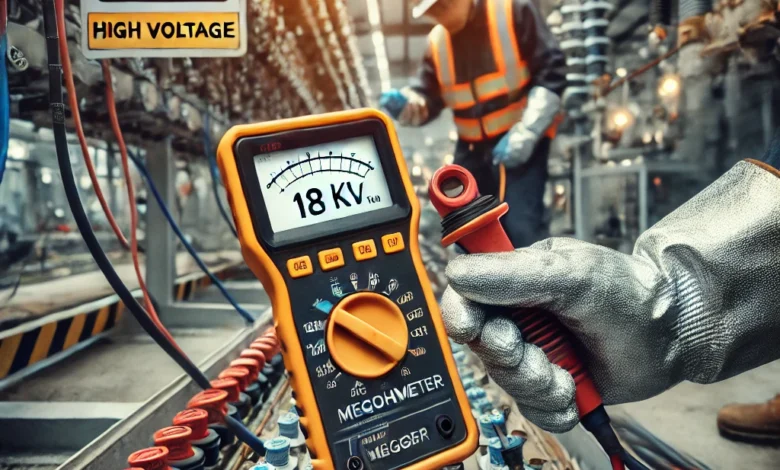Con Cuánto Se Mega un Cable de 18 kV: Detailed Guide

Testing the insulation resistance of high-voltage cables is essential to ensure the safety and reliability of electrical systems. The phrase “con cuánto se mega un cable de 18 kV” refers to the voltage level used for megger (insulation resistance) testing on a 18 kV cable. This process helps in detecting insulation deterioration, moisture ingress, and potential failures before the cable is energized.
Understanding the correct testing voltage and procedure is crucial to prevent damage to the cable and ensure compliance with industry standards. This article explains the different testing methods, recommended voltage levels, and best practices for performing a megger test on an 18 kV cable.
Importance of Megger Testing for 18 kV Cables
Megger testing, also known as insulation resistance (IR) testing, is a preventive maintenance measure used in electrical installations. High-voltage cables, like those rated for 18 kV, must have proper insulation to prevent electrical breakdowns and ensure operational efficiency. Over time, factors such as moisture, aging, mechanical damage, and chemical exposure can degrade insulation, increasing the risk of electrical faults.
Performing a megger test allows engineers and technicians to assess the condition of the insulation and determine whether the cable is safe for operation. It helps in identifying problems early, reducing the chances of unexpected failures and costly downtime.
Recommended Voltage for Megger Testing of 18 kV Cables
The appropriate test voltage for an 18 kV cable depends on the type of test being conducted. Different standards and guidelines exist for insulation testing, including IEEE, IEC, and NETA recommendations. The following are the standard test voltage levels for different megger tests:
Routine Insulation Resistance Test (DC Megger Test)
- This test measures the insulation resistance by applying a direct current (DC) voltage to the cable.
- The commonly recommended test voltage is 2.5 times the rated voltage of the cable.
- For an 18 kV cable, the typical megger test voltage is 45 kV DC (18 kV × 2.5).
- The test duration is usually 1 to 5 minutes, depending on the condition of the cable.
- A healthy insulation should have a resistance value in the range of gigohms (GΩ).
AC Withstand Test (High-Potential Test)
- This test is performed using an alternating current (AC) voltage at power frequency (50/60 Hz).
- It is used to check the dielectric strength of the insulation.
- The test voltage is generally 1.73 times the phase-to-ground voltage of the cable.
- For an 18 kV system, the typical withstand voltage is 24 kV to 36 kV AC.
- The test is conducted for one minute to ensure the cable insulation can handle operating conditions.
Insulation Resistance Measurement (Megohmmeter Test)
- This test is performed using a megohmmeter (megger), which applies a lower DC voltage (500V to 5000V) to measure insulation resistance.
- For an 18 kV cable, the recommended megger voltage is typically 2500V to 5000V DC.
- The insulation resistance should be in the range of hundreds or thousands of megohms (MΩ) or more.
Best Practices for Megger Testing of 18 kV Cables
To ensure accurate and safe testing, follow these best practices when performing a megger test on an 18 kV cable:
1. Refer to Manufacturer’s Specifications
Each cable manufacturer provides recommended test voltages and procedures. Always follow these guidelines to prevent overvoltage stress that could damage the insulation.
2. Ensure the Cable is De-Energized
Before testing, confirm that the cable is completely disconnected from any power source. Never perform a megger test on a live cable.
3. Use the Right Test Equipment
Select a high-voltage insulation tester rated for at least 5 kV or higher to test 18 kV cables effectively. Ensure the instrument is calibrated and functioning correctly.
4. Follow Safety Precautions
- Wear appropriate personal protective equipment (PPE), including insulated gloves, safety goggles, and dielectric boots.
- Maintain a safe distance from the cable under test.
- Discharge the cable properly after the test to prevent stored charge hazards.
5. Record and Compare Test Results
Keep a log of insulation resistance values for future reference. Compare results with previous tests to identify any gradual insulation degradation.
6. Perform Testing in Dry Conditions
Moisture can affect insulation resistance readings. Conduct tests in a dry environment for accurate results.
Common Issues Found in Megger Testing
During megger testing, the following problems may indicate insulation deterioration in an 18 kV cable:
- Low insulation resistance values: This suggests moisture, dirt contamination, or aging insulation.
- Fluctuating readings: Indicates possible insulation breakdown or partial discharge activity.
- Sudden drop in resistance: This may point to a severe defect, requiring further investigation.
Read also: 2014 Ford F-150 RHK DUP: A Detailed Overview of the Unique Pickup
Conclusion
Understanding con cuánto se mega un cable de 18 kV is essential for ensuring electrical system reliability and preventing insulation failures. The appropriate megger voltage depends on the test type, with 45 kV DC for routine insulation resistance tests, 24 kV to 36 kV AC for withstand tests, and 2500V to 5000V DC for insulation resistance measurement.
By following proper testing procedures, safety guidelines, and best practices, technicians can ensure accurate results and extend the life of 18 kV cables in high-voltage electrical systems. Regular megger testing is a valuable maintenance practice that helps detect potential issues early and ensures safe cable operation.




